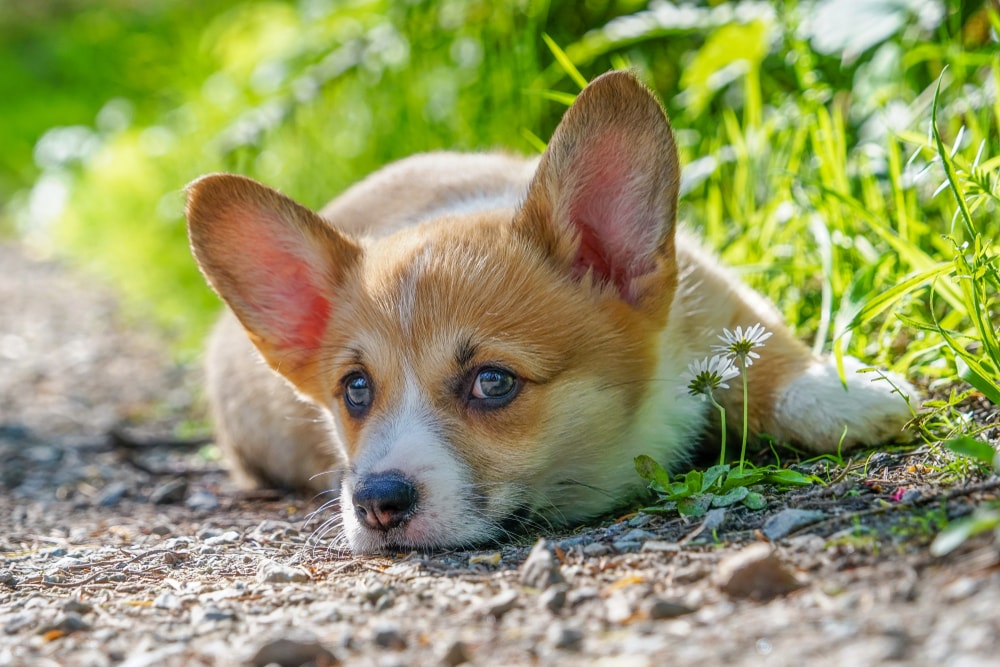Puppy-Proofing Your Home
Aside from making sure that your Pembroke will be comfortable in your home, you also have to make sure that your home is safe for your Pembroke. This means taking precautions to make sure that your pup will not get into any mischief and that there is nothing within his reach that may harm him should he sniff it, chew it, inspect it, etc.
This probably seems obvious since, while you are primarily concerned with your pup’s safety, at the same time you do not want your belongings to be ruined. Breakables should be placed out of reach if your dog is to have full run of the house. If he is to be limited to certain places within the house, keep any potentially dangerous items in the “off-limits” areas.
An electrical cord can pose a danger should the puppy decide to taste it—and who is going to convince a pup that it would not make a great chew toy? Cords should be fastened tightly against the wall, out of puppy’s sight and away from his teeth. If your dog is going to spend time in a crate, make sure that there is nothing near his crate that he can reach if he sticks his curious little nose or paws through the openings. Moreover, just as you would with a child, keep all household cleaners and chemicals where the pup cannot reach them; antifreeze is especially lethal to dogs.
It is just as important to make sure that the outside of your home is safe. Of course, your puppy should never be unsupervised, but a pup let loose in the yard will want to run and explore, and he should be granted that freedom. Do not let a fence give you a false sense of security; you would be surprised how crafty (and persistent) a dog can be in working out how to dig under and squeeze his way through small holes, or to jump or climb over a fence. The remedy is to make the fence high enough so that it really is impossible for your dog to get over it (about 5 feet should suffice), and well embedded into the ground, as a Pembroke is just as likely to go under it in pursuit of whatever attracts his attention. Be sure to secure any gaps in the fence. Check the fence periodically to ensure that it is in good shape and make repairs as needed; a very determined pup may return to the same spot to “work on it” until he is able to get over or through.
First Trip to the Vet
You have selected your puppy, and your home and family are ready. Now all you have to do is collect your Pembroke from the breeder and the fun begins, right? Well…not so fast. Something else you need to prepare is your pup’s first trip to the veterinarian. Perhaps the breeder can recommend someone in the area that specializes in Pembrokes or similar breeds, or maybe you know some other Pembroke owners who can suggest a good veterinarian. Either way, you should have an appointment arranged for your pup before you pick him up.
The pup’s first visit will consist of an overall examination to make sure that the pup does not have any problems that are not apparent to you. The vet will also set up a schedule for the pup’s vaccinations; the breeder will inform you of which ones the pup has already received and the vet can continue from there.
Introduction to the Family
Everyone in the house will be excited about the puppy’s coming home and will want to pet him and play with him, but it is best to make the introductions low-key so as not to overwhelm the puppy. He is apprehensive already. It is the first time he has been separated from his mother and the breeder, and the ride to your home is likely to be the first time he has been in a car. The last thing you want to do is smother him, as this will only frighten him further. This is not to say that human contact is not extremely necessary at this stage, because this is the time when a connection between the pup and his human family is formed. Gentle petting and soothing words should help console him, as well as just putting him down and letting him explore on his own (under your watchful eye, of course).
The pup may approach the family members or may busy himself with exploring for a while. Gradually, each person should spend some time with the pup, one at a time, crouching down to get as close to the pup’s level as possible while letting him sniff their hands and petting him gently. He definitely needs human attention and he needs to be touched—this is how to form an immediate bond. Just remember that the pup is experiencing a lot of things for the first time, at the same time. There are new people, new noises, new smells and new things to investigate, so be gentle, be affectionate and be as comforting as you can be.
Pup’s First Night Home
You have traveled home with your new charge safely in his dog crate or on a friend’s lap. He’s been to the vet for a thorough check-up; he’s been weighed, his papers examined; perhaps he’s even been vaccinated and wormed as well. He’s met the entire family, including the excited children and the lessthan- happy cat. He’s explored his area, his new dog bed, the yard and anywhere else he’s been permitted. He’s eaten his first puppy food meal at home and relieved himself in the proper place. He’s heard lots of new sounds, smelled new friends and seen more of the outside world than ever before.
That was just the first day! He’s worn out and is ready for bed…or so you think!
It’s puppy’s first night and you are ready to say “Good night”—keep in mind that this is puppy’s first night ever to be sleeping alone. His dam and littermates are no longer at paw’s length and he’s a bit scared, cold and lonely. Be reassuring to your new family member, but this is not the time to spoil him and give in to his inevitable whining.
Puppies whine. They whine to let others know where they are and hopefully to get company out of it. Place your pup in his new bed or crate in his room and close the door. Mercifully, he may fall asleep without a peep. When the inevitable occurs, ignore the whining; he is fine. Be strong and keep his interest in mind. Do not allow yourself to feel guilty and visit the pup. He will fall asleep eventually.
Many breeders recommend placing a piece of bedding from the pups former home in his new bed so that he recognizes the scent of his littermates. Others like to fill an old sock with other old socks, making a puppy-like lump for the puppy to snuggle with. Others still advise placing a hot-water bottle in his bed for warmth. The latter may be a good idea, provided the pup does not attempt to suckle—he will get good and wet and may not fall asleep so fast.
Puppy’s first night can be somewhat stressful for the pup and his new family. Remember that you are setting the tone of nighttime at your house. Unless you want to play with your pup every night at 10 p.m., midnight and 2 a.m., do not initiate the habit. Surely your family will thank you, and soon so will your pup!
Excerpt from “Comprehensive Owner’s Guide: Pembroke Welsh Corgi” by E. Hywel Burton.
Featured Image: Via Adonis Villanueva/Shutterstock.com
Share:










